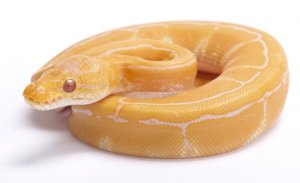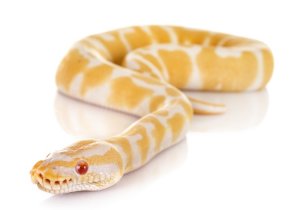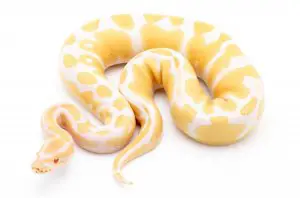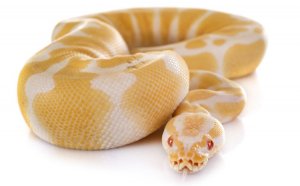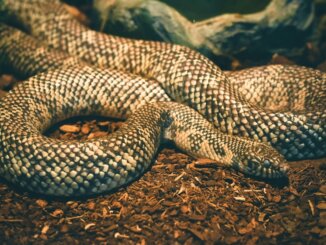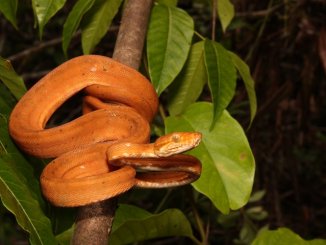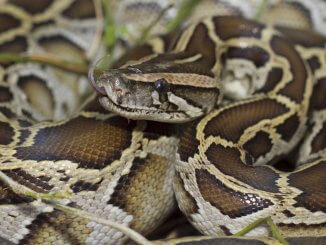Albino ball pythons are one of hundreds of ball python morphs.
This morph is very easy to spot with their white bodies, yellow markings and pink or red eyes.
Albinos make one of the best pet snakes for beginners.
They have a very docile temperament, are easy to care for and only grow three to five feet in length. This makes them a perfect snake to introduce you to the world of reptile keeping.
In this article, we will talk about how to care for an albino Ball Python. We also share their price, facts, color variations and advice on feeding and housing. Keep reading to see if an albino snake is a good match for you…
All About Albino Ball Pythons
Ball pythons are from West Africa. They first became popular in the pet trade around the 1980s. During this time, they were considered common snakes and did not have many color morphs. The wild-type ball python was the most common pet.
Wild-type species are generally a light brown with darker brown or black markings and black eyes. But, the albino has a white body with yellow markings and pink or red eyes.
Albinos were one of the first color variations to be bred (starting around 1992). Since this morph is one that naturally occurs in the wild, it was easier to breed for.
Unfortunately albino morphs do not usually survive long in the wild. They are more easily spotted by predators and tend to be prone to eye and health issues. As pets, however, they can live long and normal lives of up to 30 years.
Despite the potential health problems, albino ball pythons make an excellent pet snake.
They are very easy to care for, docile and are easy to find. It is common to find them in pet stores and from professional breeders.
Albinism is a naturally occurring trait. Genetics cause this snake to be born with very little melanin in their skin. This results in little to no body color and pink or red eyes.
Their red or pink eyes are notoriously sensitive to UV rays due to the lack of melanin. This is true for all albino species. For albino ball pythons, you should not use a UVB bulb in their tank. UVB bulbs can do more harm than good, we will discuss this more in the tank set up section.
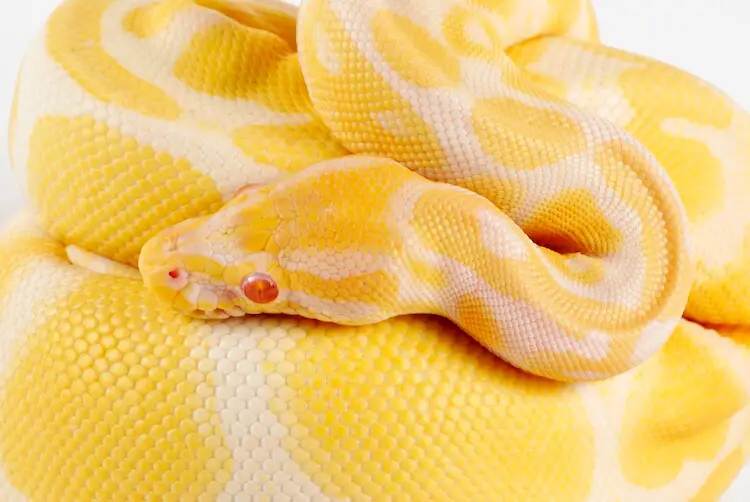
What We Like About The Albino Python
Pros
- Beautiful white body with yellow markings.
- Docile and friendly temperament that is suitable for beginners.
- Very easy to care for.
Cons
- Red or pink eyes are very sensitive to light.
- Tend to have worse eyesight than other morphs.
- More expensive than other species at $500.
Species Appearance
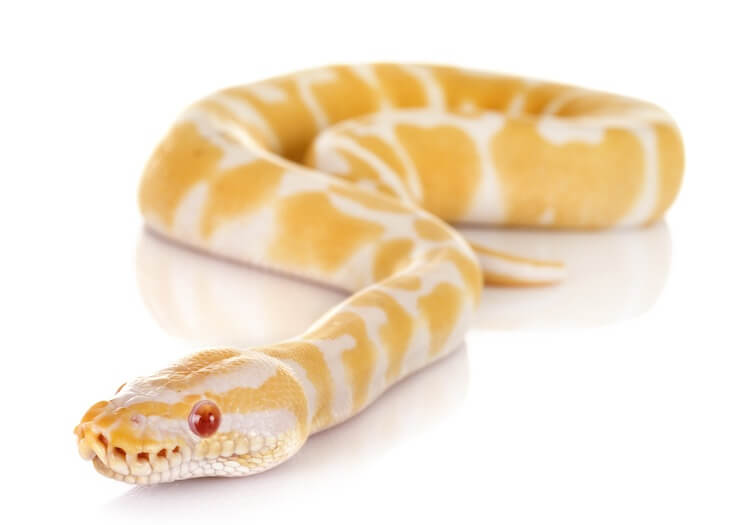
Many people love the albino ball python due to its beautiful color.
A typical albino has white and yellow markings with pink eyes and a stocky body. There is a lot of variation in the shape and saturation of these yellow markings. You can also find an albino version of many other popular ball python morphs:
- Enchi
- Bumblebee
- Banana
- Lavender albino
These beautiful white snakes can grow up to five feet in length, with females being larger than males. Females also have longer and thinner tails. A male ball python will generally have a shorter, thicker tail that tapers to a point more abruptly.
However, the size difference between males and females is not reliable enough to sex a snake.
The best way to determine the sex of your ball python is probing. Male snakes have sex organs that are stored in their body until they are ready to breed. Probing is when you take a small metal instrument and insert it into the snake’s vent, feeling for the male sex organs.
Proving should only be attempted by a veterinarian or professional breeder. If done incorrectly, this can seriously injure your snake.
How Big Does An Albino Ball Python Get?
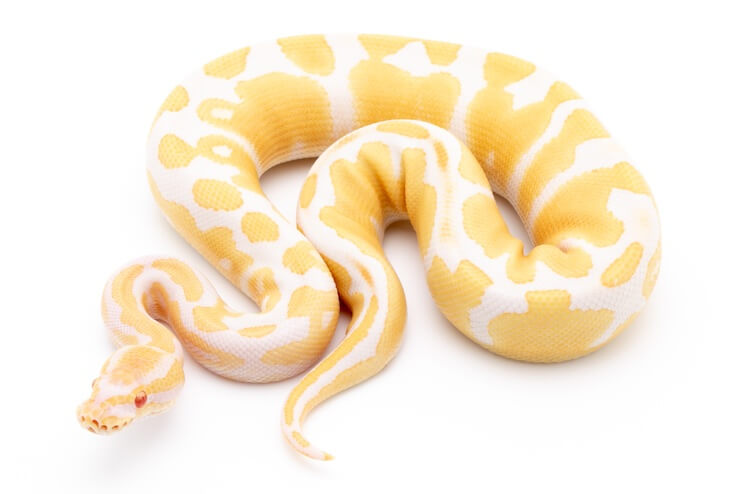
Albino Ball Pythons are the same size as any Ball Python. They are just a color morph.
Adult males will usually stop growing at 2.5 to three feet long and three pounds in weight. Females will usually top out around five feet long and about five pounds.
Males and females will be about the same size for the first six months. At this age, the size difference will begin to become apparent. Females grow at 12 to 16 inches per year, and males grow about eight inches per year.
Albino Ball Python Care Sheet
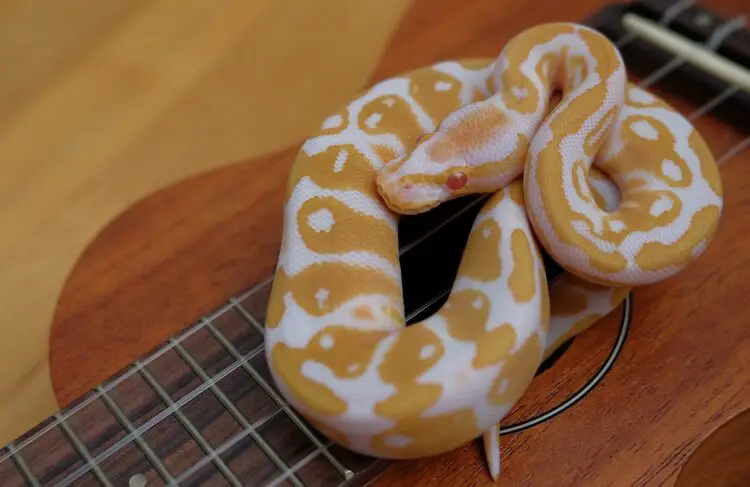
Albino ball pythons are not hard to care for, but they have slightly more complicated husbandry needs than a typical wild-type morph.
Their red eyes are very sensitive to light. Because of this, you should not use a UVB bulb in their enclosure. Instead keep the humidity a bit higher in their tank. By increasing tank humidity you will also need to check the tank’s humidity multiple times a day.
Albinos are a bit harder to care for than a normal morph, but they are well-worth the effort.
Ball Python Diet
Albino ball pythons typically eat mice, rats, shrews, voles and the occasional small bird. Like most wild animals, they will eat as often as they can, unless they have just had a meal large enough to last them for several days.
The Albino morph’s diet and feeding habits are the same as any other ball python.
Ball pythons are carnivores that tend to be rodent specialists. This means they usually only eat rodents. They will lie in wait until a rodent scurries past, then they will spring from their hiding spot and strike.
When it comes to feeding a ball python you have two choices: mice or rats.
Rats are larger and tend to have a little less fat than mice, but it is usually easier to find mice. Make sure the prey is no larger than the thickest part of your snake’s body.
Once you decide to feed mice vs rats, your next decision is whether to feed live or frozen.
Live mice or rats can easily deliver a nasty bite to your snake that could become infected. The only time it is advised to feed live prey is if your snake refuses to eat frozen thawed rodents.
If you do feed live rodents then make sure that you watch your snake the entire time.
| Snake Age | Snake Weight (grams) | Mice | Rats | Frequency |
|---|---|---|---|---|
| Hatchling | 50-100 | 1 Hopper mouse | 1 Pinky rat | 5-7 days |
| 6 Months | 275-360 | 1 Adult mouse | 1 Rat pup | 7-10 days |
| 1 Year | 500-800 | 1-3 Adult mice | 1 Small rat | 10-14 days |
| 1.5 Years | 600-1400 | 3-6 Adult mice | 2 Small rats | 10-14 days |
| 3 Years+ | 900-2000 | 4-5 Adult mice | 1 Medium rat or 2 small rats | 2-3 weeks |
Known Health Issues
Albino snakes are known for having eyes that are very sensitive to light.
This can be resolved by simply avoiding the use of a UVB bulb. They are not necessary for any ball python morph. It is better not to include a UVB bulb in your albino ball python’s setup.
They suffer from Photodermatitis and photokeratitis. These are both health issues that can result from exposure to improper UV lighting:
- Photodermatitis, also known as sun poisoning, happens when an allergen is activated by exposure to sunlight or UVB bulbs. This can cause a rash, inflammation of the skin, and sunburn.
- Photokeratitis is a sunburn on the eye. As you can imagine, this is incredibly painful for a snake, and if exposure to the UVB bulb is continued, it can lead to blindness.
As a species Ball Pythons are hardy and healthy. But, they do have some health issues that can happen due to improper care and bad husbandry.
Common health issues include: mites, respiratory infections, and mouth rot. Most of these issues are easily avoided with the proper care.
Respiratory issues are a common issue in all ball pythons. They are usually caused by improper humidity levels. If the humidity is too high, the constant moisture in the nostrils can cause an infection. Likewise, if the humidity is too low, the skin in the nostrils can dry out and lead to infection.
Another issue in ball pythons is mouth rot. Improper temperature and humidity are common causes of this disease. Symptoms include pus in your snake’s mouth that resembles cottage cheese, a swollen mouth, or breathing with its mouth open.
Signs They Are Healthy
- Good appetite.
- Smooth, shiny scales.
- Sheds regularly.
- Alert behavior.
Sickness Symptoms
- Lack of appetite.
- Pus or mucus in the mouth.
- Open-mouthed breathing.
- Lethargy.
Albino Ball Python Enclosure
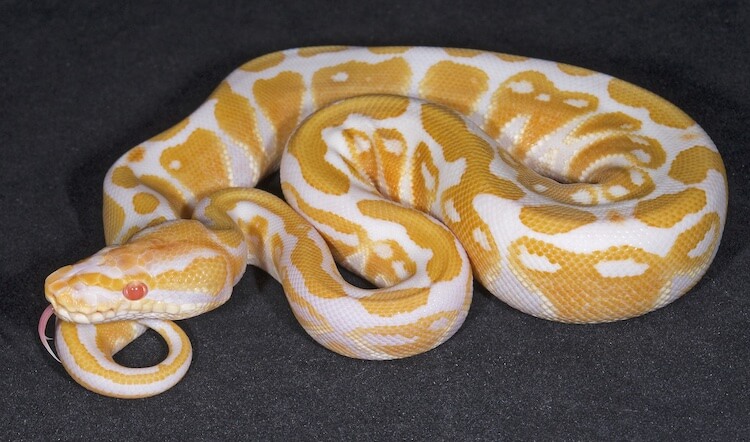
In the wild ball pythons are used to a warm environment. They generally prefer areas with lots of cover and are more active at dusk and dawn. During the day, they find somewhere safe to sleep, such as under rocks, in dense shrubbery, or in burrows.
When setting up an albino ball python’s enclosure, you should take care to replicate these conditions.
Like any other ball python morph, they need a reptile enclosure that is at least 55-gallons. Glass aquariums are the most common type of enclosure, although some keepers prefer plastic tubs. Tubs are cheaper and hold humidity better.
Any type of enclosure should be at least long enough for the snake to stretch itself out fully. For females this can be five feet long.
As snakes with albinism are more sensitive to light, it is usually a good idea to avoid buying an extra light for their enclosure. A light left on in a room is enough to create a day/night cycle.
Using a heating mat is generally less expensive a better than a heating bulb. It is also ideal since it doesn’t heat the air as much as a heating bulb. This allows you to better control the ambient temperature. You should keep the mat under the tank so that the bottom of the enclosure and the substrate create enough of a barrier to avoid burning the snake.
The hot side of your snake’s tank should measure at 88 to 92°F and should never exceed 95°F.
The cool side should measure 76 to 80°F and never dip below 75°F.
Tank or tub humidity levels should measure between 55 and 60%. A 5% higher humidity may prove beneficial for an albino ball python. Their sensitive skin will likely be helped by the extra humidity. This can be done by misting the tank daily, or putting a water bowl over the under tank heater.
Décor and Substrate
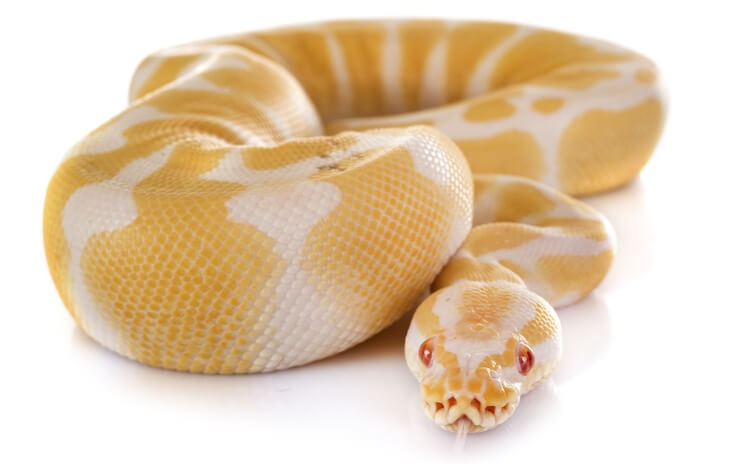
One of the best substrates is cypress mulch. It is excellent at retaining moisture. Shredded aspen is a good alternative if you cannot find cypress mulch. It also does well at holding humidity, and it allows your snake to burrow under the bedding.
You should avoid any type of cedar or pine beddings. They contain oils that can be fatal to your snake.
Finally, it is important to have multiple hides and other décor inside the enclosure.
Hides and cover will allow your albino ball python to feel safe and secure while sleeping. If you decide to include décor, you can use soft plastic plants to create more cover and some type of log they can rub against to help them shed.
Avoid any hides or décor made of hard plastic; the hard plastic edges can cut your snake.
Typical Behavior
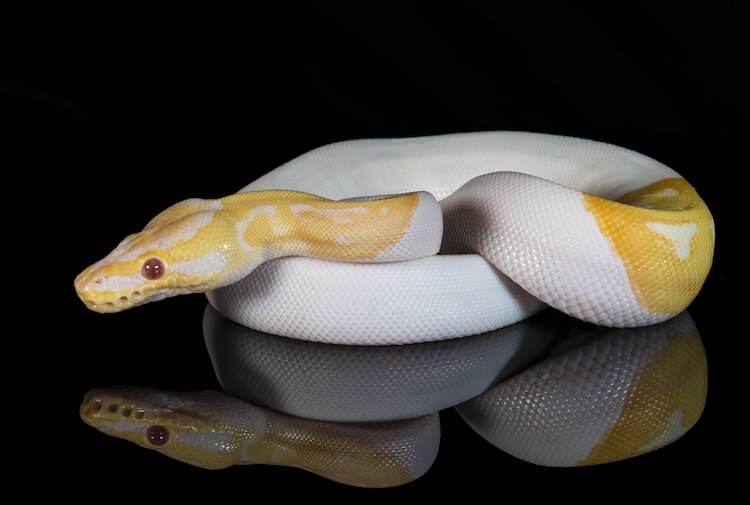
Ball pythons are very shy snakes, Albino morphs included too. When threatened, they will coil tightly into a ball and tuck their head under their body and hold very still. They try to look like rocks to any passing predators.
However, due to an albino ball python’s bright coloring, this tactic does not work for them.
In the wild they are at a much higher risk of predation due to their inability to camouflage.
To display aggression, these snakes will hiss and only strike very rarely. If a snake has the upper portion of its body off the ground and leans back, coiled into an s shape, this is a warning that they are about to strike.
Pet pythons are pretty shy, so they will likely spend most of their time in their hide or somewhere in the tank that provides them with cover.
There are two common behaviors you will likely see.
Periscoping is when your snake lifts its head and neck high off the ground and looks very alert. This means your snake is interesting in its surroundings and is checking things out.
Coiling into a tight ball is another common behavior. If your albino is balled up, this means you need to back off and leave them alone. They do this when they are stressed, afraid or shedding.
Do Ball Pythons Like Handling?
Albino individuals are known for being a bit more nervous and fearful since they are prone to poor eyesight. It may take a bit more time to get them to enjoy handling.
With patience, these ball pythons can be handled just as easily as any other morph.
Albino ball pythons are usually very docile. They do not get overly stressed by handling. However, this does not mean they will not strike.
Most first time keepers receive bites when removing them from their enclosure. One way to avoid this is to use a snake hook rather than just your hand.
The biggest thing to avoid is bringing your hand down above the snake’s head or bringing your snake’s face close to yours. Both of these actions can convince your snake that you are a predator trying to eat them.
How Much Is An Albino Ball Python?
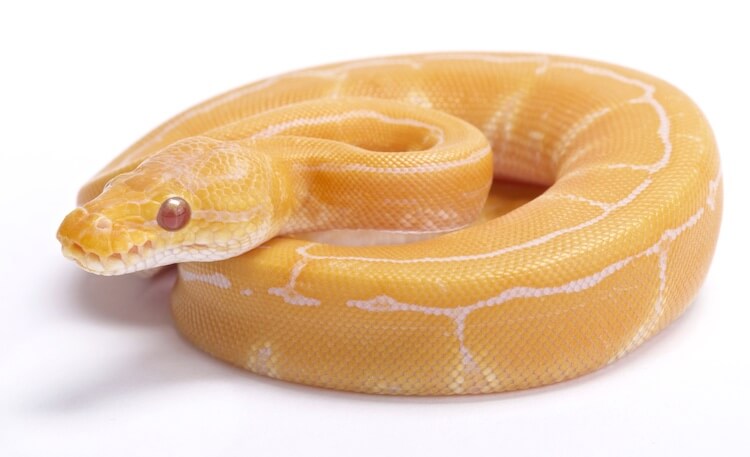
The price of an albino ball python can range anywhere from $300 to $500. This depends on the snake’s markings and genetics. A wild-type species will only cost $30-$100. Albinos are quite a bit more expensive.
Prices can fluctuate quite a bit, so you may even see some closer to $1,000 USD.
Albinos are generally very easy to find in pet stores, from reputable breeders online, and at reptile shows.
One of the biggest tells of a good breeder is that all their snakes look healthy and active. Healthy snakes will have bright eyes and scales, will be moving around and otherwise look alert.
A good breeder should also be able to tell you about your snake’s genetics, any health issues, the sex of your snake, how old your snake is, what they have been feeding the snake, and how it has been housed. Great breeders will also have many excellent references.
No matter where you are purchasing your snake from, you will want to be sure they are captive-bred and not wild-caught. While this is usually not an issue as albino ball pythons are not common in the wild, it is always important to check.
| Albino Snake Facts | |
|---|---|
| Common Name | Albino Ball Python |
| Scientific Name | Python Regius |
| Price | $300 to $500 |
| Size | 3 – 5 feet long |
| Lifespan | 20 to 30 years |
| Diet | Rodents |
| Tank Size | 55-gallon tank |
| Humidity & Temperature | Temperature: 76 – 93°F Humidity: 50 – 60% |
| Popular Alternatives | Corn snakes, milk snakes and king snakes. |
Summary
The albino ball python is a morph that has a stunning white and yellow color pattern. They come in a variety of patterns as you can find an albino version of almost any other ball python morph.
These snakes thrive in warm, moist environments and need lots of places to hide in their tank or tub. They also need a temperature gradient so that they can thermoregulate like they would in the wild.
Just make sure that you do not use a UVB light with this morph. They tend to be more sensitive to light and can potentially get sunburns or eye damage from UV rays. It is better to just avoid the risk entirely since ball pythons do not require UVB lights to stay healthy.
Albino ball pythons are a great beginner snake. They are docile, easy to care for and beautiful to see.
Does this albino python sound like the perfect match for you? Let us know!

